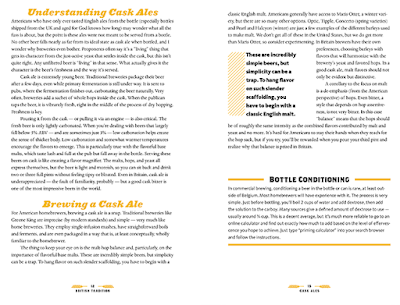 |
| A satisfied customer! |
The Techniques
The Secrets of Master Brewers describes the way classic, archetypal beers are made at the breweries that made them famous. You definitely get the details of mash rests, boil lengths, and fermentation processes, but you also get to hear how brewers think about beer, what they emphasize in their own brewing, their ingredient selection, and specific techniques to bring out the flavors they prize. There's an anthropologic bent throughout. For example:
- John Keeling (Fuller's) explains parti-gyle brewing, and
- Ian Cameron (Traquair) emphasizes the importance of open fermentation.
- Hans-Peter Drexler (Schneider and Sohn) gives the lowdown on ferulic acid rests, and
- Matthias Trum (Bahnhof) provides techniques to conduct lactic fermentations.
- Hedwig Neven (Duvel) describes how to achieve balance in yeast-driven ales, and
- Alexis Briol (St. Feuillien) offers a tutorial on subtle spice infusions in biere de Noel.
- Of course, I didn't neglect the US, and Ben Edmunds (Breakside) gives a seminar on modern techniques for making hoppy ales, while
- Brian Mandeville (Fullsteam) advises readers how to use corn in their brewing.
 |
| click to enlarge |
I recognize not everyone is going to want to buy this book. I hope everyone does pick it up and page through it to see what jumps out. Beer-making is not just a chemical process. It has evolved over the centuries and includes a whole range of local philosophies, approaches, and techniques. If you want to understand how brewers think about the beers they invented, this is your best resource. And, if you want to brew those beers yourself, that's cool, too. Amazon is currently offering a pretty good price, so act now! :-)


Congratulations! Here's hoping this will contribute to the US (and Ireland, for that matter) learning how to do cask properly.
ReplyDeleteThank you, sir. I would settle for convincing A FEW of them to just appreciate them. But I'm a man of modest goals.
ReplyDeleteSadly, I think the US craft industry is too far gone. Too many of them are raised on the BJCP gospel that brewing is some kind of black box. Water recipe + hop and malt recipe + standard brewing process = beer to style!!!
ReplyDeleteHomebrewers are our only hope, but only if they can find this gem in the litter box full of Gordon Strongs and Ray Daniels and Jamil Zainasheffs.